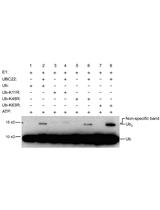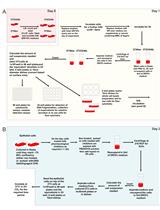- Submit a Protocol
- Receive Our Alerts
- Log in
- /
- Sign up
- My Bio Page
- Edit My Profile
- Change Password
- Log Out
- EN
- EN - English
- CN - 中文
- Protocols
- Articles and Issues
- For Authors
- About
- Become a Reviewer
- EN - English
- CN - 中文
- Home
- Protocols
- Articles and Issues
- For Authors
- About
- Become a Reviewer
Protocol for Apoptosis Assay by Flow Cytometry Using Annexin V Staining Method
Published: Vol 3, Iss 6, Mar 20, 2013 DOI: 10.21769/BioProtoc.374 Views: 36624

Protocol Collections
Comprehensive collections of detailed, peer-reviewed protocols focusing on specific topics
Related protocols

Measuring Procaspase-8 and -10 Processing upon Apoptosis Induction
Sabine Pietkiewicz [...] Inna N. Lavrik
Jan 5, 2017 10531 Views

An in vitro Co-culture System for the Activation of CD40 by Membrane-presented CD40 Ligand versus Soluble Agonist
Khalidah Ibraheem [...] Nikolaos T. Georgopoulos
Jul 5, 2018 9236 Views
Abstract
This assay is used to count the number of cells that have undergone apoptosis. Apoptosis will be detected by initially staining the cells with Annexin V and propidium iodide solution followed by flow cytometry analysis. It is based on the principle that normal cells are hydrophobic in nature as they express phosphatidyl serine in the inner membrane (side facing the cytoplasm) and when the cells undergo apoptosis, the inner membrane flips to become the outer membrane, thus exposing phosphatidyl serine. The exposed phosphatidyl serine is detected by Annexin V, and propidium iodide stains the necrotic cells, which have leaky DNA content that help to differentiate the apoptotic and necrotic cells.
Keywords: ApoptosisMaterials and Reagents
- Annexin V FLUOS staining kit (F. Hofformann-La Roche, catalog number: 11858777001 )
- The kit contains ready-to-use Annexin-V-FLUOS solution, propidium iodide solution, and incubation buffer
- Trypsin
- NaCl
- KCl
- Na2HPO4
- KH2PO4
- PBS buffer (pH 7.4) (see Recipes)
Equipment
- Flow cytometer
- Centrifuge
- T25 culture flask
Procedure
- Seed cells (1 x 106 cells) in a T25 culture flask (in triplicate for experiments) and three T25 culture flask for control (unstained, Annexin only, and propidium iodide only)
- After 48 h incubation, collect the supernatant (floating apoptotic cells) and trypsinize the adherent cells (~2 x 106 cells) from each T25 flask (combine respective floating and trypsinized cells resulting in six tubes).
- Wash the collected cells twice with PBS and centrifuge (670 x g, 5 min, RT).
- Re-suspend each pellet (~2 x 106 cells) in PBS (400 μl).
For experimental cells (Triplicate) - (400 μl of cells + 100 μl of incubation buffer with 2 μl of Annexin [1 mg/ml] and 2 μl of propidium iodide [1 mg/ml]).
For control cells
Control 1: (Unstained) - (without any stain (400 μl of cells + 100 μl of incubation buffer)
Control 2: (Annexin V only) - (400 μl of cells + 100 μl of incubation buffer with 2 μl of Annexin (1 mg/ml))
Control 3: (Propidium iodide only) - (400 μl of cells + 100 μl of incubation buffer with 2 μl of Propidium iodide (1 mg/ml))
- Analyze the cells using a flow cytometry without washing the cells
Cells that were propidium iodide (PI) negative and Annexin V negative are considered healthy, cells, PI negative and Annexin V positive cells are considered apoptotic, and cells that are positive to both PI and Annexin V considered necrotic (Figure 1).

Figure 1.
Recipes
- PBS buffer (pH 7.4)
8 g NaCl
0.2 g KCl
2.3 g Na2HPO4
0.22 g KH2PO4
In 800 ml of distilled H2O adjust the pH to 7.4
Acknowledgments
The authors thank Dr. Palanimuthu Ponnusamy Moorthy and Dr. Dhanya Haridas for critical reading of the apoptosis experimental protocol. We also thank Philip Hexley and Victoria Smith, Flow Cytometry Research Facility at UNMC, for their support.
References
- Lakshmanan, I., M. P. Ponnusamy., S. Das., S. Chakraborty., D. Haridas., P. Mukhopadhyay., S. M. Lele and S. K. Batra (2012). MUC16 induced rapid G2/M transition via interactions with JAK2 for increased proliferation and anti-apoptosis in breast cancer cells. Oncogene 31(7): 805-817.
Article Information
Copyright
© 2013 The Authors; exclusive licensee Bio-protocol LLC.
How to cite
Lakshmanan, I. and Batra, S. K. (2013). Protocol for Apoptosis Assay by Flow Cytometry Using Annexin V Staining Method. Bio-protocol 3(6): e374. DOI: 10.21769/BioProtoc.374.
Category
Cancer Biology > Cell death > Cell biology assays > Apoptosis
Cancer Biology > General technique > Cell biology assays > Cell viability
Cell Biology > Cell-based analysis > Flow cytometry
Do you have any questions about this protocol?
Post your question to gather feedback from the community. We will also invite the authors of this article to respond.
Share
Bluesky
X
Copy link











